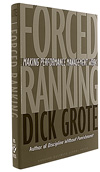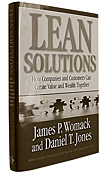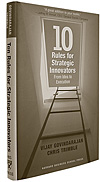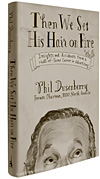Books in Brief
“Rank and yank” defended, consumers empowered, innovators differentiated, and Michael Jackson inflamed.
(originally published by Booz & Company)Forced Ranking: Making Performance Management Work
By Dick Grote
Harvard Business School Press, 2005
276 pages, $35.00
 |
|
Photograph montage by Rick Schwab |
The author makes it clear that forced ranking (of which the 20/70/10 formula is but one example) is needed because most conventional performance appraisal systems are deficient, especially when it comes to differentiating management talent, which, in his view, is the key to building a culture of performance. This deficiency is rooted in the widespread reluctance of managers to give their subordinates poor performance ratings. The result is ratings “inflation” and a work force with members whose performances, like the children in Garrison Keillor’s fictional town Lake Wobegon, are all “above average.” This tendency can be remedied to some extent by top management’s insisting on the forced distribution of ratings, so that only a few people can qualify for superior appraisal ratings. Mr. Grote devotes an entire chapter to how to make this “tweaking” of the performance appraisal system effective, but he clearly thinks it inferior to a full-blown, rigorous talent assessment system.
 Although Mr. Grote is a vocal advocate for forced ranking, he is sensitive to the many criticisms that have been made of it, and he is precise about how and when it should be used. His guidelines: First, it should be used only in organizations with more than 100 employees; managers in smaller businesses should be able to identify their “stars” and “duds” without a formal, mechanistic system. Second, it is but one element of performance management, and most organizations would be better served by getting their performance appraisal system in order. Third, in most organizations, forced ranking should be performed at a different time from regular performance appraisals, and for only a limited period, such as two or three years. This is particularly true for systems in which the bottom performers are fired. If “rank and yank” is used for too long, the process will begin to cut muscle and bone rather than fat. Last, forced ranking should be applied only to those individuals with the greatest impact on the organization’s results — senior management and specialist individual contributors — and if it’s phased in, it should start at the top.
Although Mr. Grote is a vocal advocate for forced ranking, he is sensitive to the many criticisms that have been made of it, and he is precise about how and when it should be used. His guidelines: First, it should be used only in organizations with more than 100 employees; managers in smaller businesses should be able to identify their “stars” and “duds” without a formal, mechanistic system. Second, it is but one element of performance management, and most organizations would be better served by getting their performance appraisal system in order. Third, in most organizations, forced ranking should be performed at a different time from regular performance appraisals, and for only a limited period, such as two or three years. This is particularly true for systems in which the bottom performers are fired. If “rank and yank” is used for too long, the process will begin to cut muscle and bone rather than fat. Last, forced ranking should be applied only to those individuals with the greatest impact on the organization’s results — senior management and specialist individual contributors — and if it’s phased in, it should start at the top.
Mr. Grote’s book will not end the controversy over forced ranking as a management technique: The visceral feelings of fans and critics run too deep. But its balanced approach, complete with model memos and scripts for managers, FAQs about forced ranking programs, and discussion of the legal pitfalls, make it an essential reference for managers who are concerned about the management of performance in their organizations.
Lean Solutions: How Companies and Customers Can Create Value and Wealth Together
By James P. Womack and
Daniel T. Jones
Free Press, 2005
366 pages, $30.00
 Lean Solutions is the fifth book from the writing partnership of James Womack and Daniel Jones, chairman and president, respectively, of the Lean Enterprise Institute. They have become well-known as the founders of the “lean production” movement, the basis of which they first encountered in the 1980s in the guise of the Toyota production system (TPS) during MIT’s five-year study of the future of the automobile. (See “Leaning Toward Utopia,” by Art Kleiner, s+b, Summer 2005.) The authors’ first four books looked at lean practices in manufacturing processes. Now this muda-hunting duo (muda is the Japanese word for waste of any kind) have turned their attention to the waste of consumers’ time and effort.
Lean Solutions is the fifth book from the writing partnership of James Womack and Daniel Jones, chairman and president, respectively, of the Lean Enterprise Institute. They have become well-known as the founders of the “lean production” movement, the basis of which they first encountered in the 1980s in the guise of the Toyota production system (TPS) during MIT’s five-year study of the future of the automobile. (See “Leaning Toward Utopia,” by Art Kleiner, s+b, Summer 2005.) The authors’ first four books looked at lean practices in manufacturing processes. Now this muda-hunting duo (muda is the Japanese word for waste of any kind) have turned their attention to the waste of consumers’ time and effort.
The six things that lean consumers demand are: solve my problem completely, don’t waste my time, provide exactly what I want, deliver value where I want it, supply value when I want it, and reduce the number of decisions I must make to solve my problems. The authors dub the challenge of meeting these demands “lean provision,” and they devote a chapter to each of them. They start by “mapping” what should be a simple task, getting one’s automobile repaired, to show how much time is wasted. An average visit to the auto repair shop, they report, takes three and a half hours, more than 70 percent of which (nearly two and a half hours) creates no value at all to the customer. By the time Dr. Womack and Mr. Jones have finished tweaking the lean version of the process, the total time consumed has been reduced to one and a quarter hours, of which only 30 percent (just over 20 minutes) is wasted.
Sometimes lean solutions seem to flout conventional wisdom. For instance, many firms tacitly assume that the customer’s time is “free” and try to minimize the firm’s hourly costs by staffing help desks with cheap, unskilled labor. The result is that consumers often spend a good deal of their time searching for answers to their problems. The lean solution is to inject intelligent feedback into the situation by putting relatively expensive, well-trained people into the first line of respondents, where the customer’s problem can be either solved or correctly directed after just one encounter. Fujitsu Services is an example of one company that has thrived by organizing help desks in this way.
Companies that pursue lean solutions can segment their markets creatively, moving beyond segmentation into rigid product and demographic categories. For example, Tesco, the incredibly successful British supermarket chain, found that the same customers are prepared to buy the same products at a wide range of price points, depending on the circumstances and context in which a shopping decision is made. Tesco has used this information in combination with state-of-the-art supply chain management to present itself to its consumers in four different store formats. Traditional Tesco supermarkets are now complemented by large “Tesco Extra” stores on suburban perimeters, where they compete with Wal-Mart–type “big box” stores. There are smaller “Tesco Metro” stores on fancy, city-center shopping streets, and even smaller “Tesco Express” convenience stores in gas stations and at busy intersections. All the formats, including the online service Tesco.com, have different pricing, but are supported by the same lean logistics system.
Many of the service scenarios discussed in this well-written, provocative book may never come to pass, but Dr. Womack and Mr. Jones have given managers a whole new way of thinking through the opportunities that lie ahead.
10 Rules for Strategic Innovators: From Idea to Execution
By Vijay Govindarajan and
Chris Trimble
Harvard Business School Press, 2005
252 pages, $29.95
 Successful firms have to perform two broad sets of activities that are often antagonistic toward each other. On the one hand, they have to offer reliable products and services at reasonable prices; on the other hand, they have to innovate continually to develop new customer offerings. Management theorists usually call these two dynamics “exploitation” and “exploration,” and the debate about their true nature and the relationship between them is a hot topic in the academic world.
Successful firms have to perform two broad sets of activities that are often antagonistic toward each other. On the one hand, they have to offer reliable products and services at reasonable prices; on the other hand, they have to innovate continually to develop new customer offerings. Management theorists usually call these two dynamics “exploitation” and “exploration,” and the debate about their true nature and the relationship between them is a hot topic in the academic world.
Now Vijay Govindarajan, professor of international business at the Tuck School of Business at Dartmouth College, and Chris Trimble, a consultant and adjunct associate professor at Dartmouth, have written a book that deals with the challenge that strategic innovation (their phrase for “exploration”) poses for mature firms, which are often happier exploiting their existing competencies than developing new ones. Strategic innovations always involve the discovery and development of new, unproven business models, although these new models are not necessarily disruptive to a firm’s existing business. Using research on more than 30 companies and interviews with dozens of executives, the authors frame the dialectic between exploration and exploitation as a tension between “CoreCo,” the established business, and “NewCo,” the strategic experiment. To be successful, NewCo must overcome three challenges: It must forget some elements of CoreCo’s business, it must borrow others, and it must learn from its own experiences. In the process, NewCo must develop a different organizational DNA (staff, structure, system, culture).
The NewCo/CoreCo nomenclature makes for clarity, but it can also make for tedious reading. Fortunately, the authors leaven their writing with stories drawn from their research, and these show how difficult it can be, even for star innovators like Corning Inc. and Hasbro Inc., to find the right dynamic blend of forgetting, borrowing, and learning. There are some excellent chapters on the ways in which corporate behavior that would be perfectly reasonable in the CoreCo environment can actually inhibit learning in the NewCo context. Given the wide range of potential applications, it’s not entirely surprising that the 10 “rules” presented by the authors (produced, no doubt, by a demand for “take-aways”) are a mélange of assertions and injunctions. There are, however, a few useful guidelines: NewCo’s organization and planning process must be built from scratch, not borrowed from CoreCo, and the NewCo management must be held accountable for learning rather than for results. This latter requirement, which will almost certainly be at odds with the performance management culture within CoreCo, is just one of the challenges of strategic innovation for established organizations.
Then We Set His Hair on Fire: Insights and Accidents from a Hall-of-Fame Career in Advertising
By Phil Dusenberry
Portfolio, 2005
304 pages, $24.95
 Phil Dusenberry is the former chairman and chief creative officer of the advertising agency BBDO, the flagship of the Omnicom media empire. The title of his new book is derived from the notorious film shoot for Pepsi-Cola starring Michael Jackson, when a flame leapt from a special effects firework to set the pop idol’s hair alight. Jackson came away with minor burns; Pepsi reaped a huge bonus from the attendant publicity.
Phil Dusenberry is the former chairman and chief creative officer of the advertising agency BBDO, the flagship of the Omnicom media empire. The title of his new book is derived from the notorious film shoot for Pepsi-Cola starring Michael Jackson, when a flame leapt from a special effects firework to set the pop idol’s hair alight. Jackson came away with minor burns; Pepsi reaped a huge bonus from the attendant publicity.
The book is about insights in business — how to get them, how to recognize them, and how to keep them coming. For Mr. Dusenberry, insight is the pivotal mediator in what he calls the “linear matrix” of research, analysis, insight, strategy, and execution (RAISE for short). Insights are powerful understandings that generate ideas for action, which allow products to stand out in what the author calls a “parity economy” — an economy in which most products are regarded as much the same. And that’s where insights come in, often from unexpected places. BBDO believes, for example, that customers are most candid about their feelings when they are complaining about a product or service, and thus complaints are a fertile source of insights. Insights often require in-depth research. In England, a research assistant sat in a café for five days, eavesdropping on the conversations of young women, and discovered that they were deterred from smoking by appeals to their vanity — worries that their faces might wrinkle — rather than by any concerns about their health. This kind of research, applied common sense, need not cost a lot of money; it can be done by anyone, and the payoffs can be huge.
If advertising is to “move the needle” — to make a real difference — it demands a marriage of logic and emotion: research and analysis to uncover the truth, and emotion to express it in a compelling way. Insight is the go-between in this relationship. The final chapter of the book contains 18 guidelines (not rules) for creative directors on how to build and sustain an insight-generating machine. None of them are new and many have been expressed before by advertising legends like David Ogilvy, but the fact that they bear repeating here underlines how difficult it can be to follow them in practice.![]()
Reprint No. 06112
Author profile:
David K. Hurst (david@davidkhurst.com) is a contributing editor of strategy+business. His writing has also appeared in the Harvard Business Review, the Financial Times, and other leading business publications. Mr. Hurst is the author of Learning from the Links: Mastering Management Using Lessons from Golf (Free Press, 2002).

